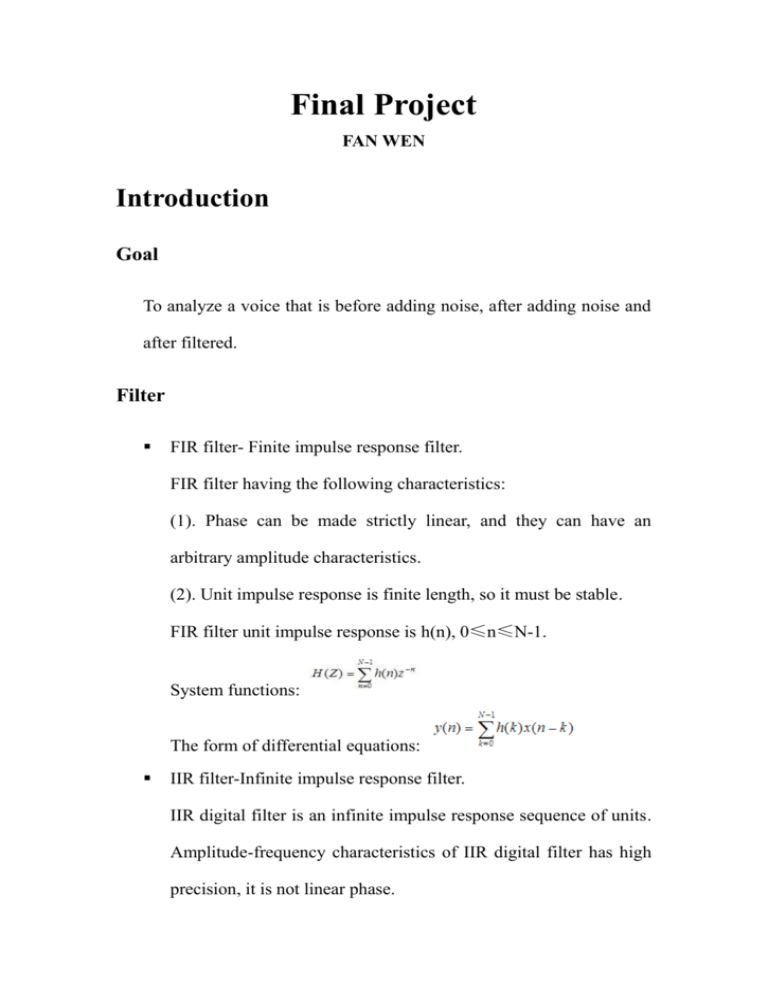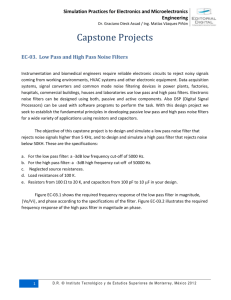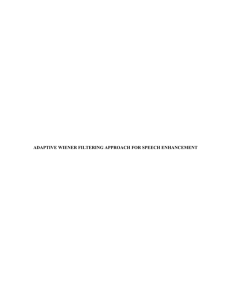
Final Project
FAN WEN
Introduction
Goal
To analyze a voice that is before adding noise, after adding noise and
after filtered.
Filter
FIR filter- Finite impulse response filter.
FIR filter having the following characteristics:
(1). Phase can be made strictly linear, and they can have an
arbitrary amplitude characteristics.
(2). Unit impulse response is finite length, so it must be stable.
FIR filter unit impulse response is h(n), 0≤n≤N-1.
System functions:
The form of differential equations:
IIR filter-Infinite impulse response filter.
IIR digital filter is an infinite impulse response sequence of units.
Amplitude-frequency characteristics of IIR digital filter has high
precision, it is not linear phase.
Application
Step1
Load a voice in the MATLAB.
Making WAV files transform to variable.
Calculate the array length. (I.e. it is the greater one between
number of rows and columns)
Find the spectrum of original signal .(using FFT)
Draw the original signal waveform and spectrum with MATLAB.
Step2
Define a random noise.(using function randn(n,1))
Adding the noise into original voice.
Find the spectrum of the signal which is adding the noise.(using
FFT)
Draw the signal that is already added the noise waveform and
spectrum with MATLAB.
Step3
Design a low pass filter.
Parameter of filter:
Window: hamming.
Order: 16
Fs: 8000
Fc: 1200
Let the mixed signal through the filter.
Find the spectrum of the signal which is already filtered.
Draw the signal waveform and spectrum after filtered with
MATLAB.
Step4
Replay and listen the voices, to see what differences with those
voices.
To set out those new generation of audio files.
Result
The filter can filter high frequency noise, but cannot clean all
noise that added into the signal.
Because it is a low pass filter, we find the voice getting dreary and
low.
Signal waveforms and spectrums:
Conclusion
In this project, I select a speech signal as the analysis object, and
carries on the spectrum analysis. Using random function of MATLAB to
create noise and add the noise to the voice signal, to imitate the noise
speech signal, and carries on the spectrum analysis. Design FIR filter
with MATLBA, and carries on speech signal contaminated by noise
filtering, analysis the signal features of time domain and frequency
domain which is after filtering. Reply the speech signal.
In summary, the project is successful. I have learned that theory to
practical combination is very important. I know how to use MATLAB
and many knowledge of filter and signal by this project.
Bibliography & References
[1].CHI-TSONG C. Digital Signal Processing-Spectral Computation and
Filter Design [M].London Oxford University Press,2002:198-205.
[2]. John G. Proakis, Dimitris G Manolakis. Digital Signal Processing 4th
edition Upper Saddle River, N.J.: Pearson Prentice Hall, 2007.
MATLAB CODE
[y,fs,bits]=wavread('test');
n=length(y);
Y=fft(y);
figure
subplot(2,1,1);plot(y);
title('The original signal waveform');grid;
subplot(2,1,2);plot(abs(Y));
title('Spectrum of the original signal');grid;
sound(y);
Noise=0.05*randn(n,1);
s=y+Noise;
S=fft(s);
figure
subplot(2,1,1);plot(s);
title('signal waveform(After adding noise)');grid;
subplot(2,1,2);plot(abs(S));
title('signal spectrum(After adding noise)');grid;
sound(s);
a=GS;b=1;c=filter(a,b,s);
C=fft(c);
figure
subplot(2,1,1);plot(c);
title('signal waveform(After filter noise)');grid;
subplot(2,1,2);plot(abs(C));
title('signal spectrum(After filter noise)');grid;
sound(c);
wavwrite(s,fs,bits,'test+Noise.wav');
wavwrite(c,fs,bits,'test+Noise+filter.wav');









